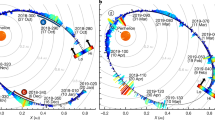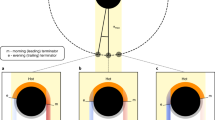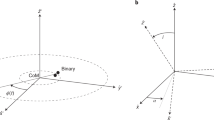Abstract
THE contribution to the zodiacal light (ZL) by interstellar grains has been estimated1–3, but, as suggested here, new observations and analyses of the ZL and of the local interstellar medium provide a firmer basis for placing limits on the brightness of the interstellar (IS) relative to the interplanetary (IP) component. The proposed NASA/ESA ‘out-of-ecliptic’ (or ‘solar polar’) mission4 provides the best and perhaps the only observational method to distinguish between these two components.
This is a preview of subscription content, access via your institution
Access options
Subscribe to this journal
Receive 51 print issues and online access
$199.00 per year
only $3.90 per issue
Buy this article
- Purchase on Springer Link
- Instant access to full article PDF
Prices may be subject to local taxes which are calculated during checkout
Similar content being viewed by others
References
Öpik, E. J. Proc. R. Irish Acad. 54 A, 165 (1951).
Greenberg, J. M. Space Res. 9, 445 (1969).
Lillie, C. F. The Scientific Results from OA002, (ed. Code, A. O.) 95 (NASA SP-311, 1972).
Fisk, L. A. & Axford, W. I. (eds) Proc. Symp. Study of the Sun and Interplanetary Medium in Three Dimensions (NASA Publ. X-660-75-53, 1976).
Greenberg, J. M. in Cosmic Dust, (ed. McDonnell, J. A. M.) chap. 4, 187 (Wiley, London, 1978).
McLintock, W., Henry, R. C., Moos, H. W. & Linsky, J. L. Astrophys. J. Lett. 204, L103 (1976).
Lyttleton, R. A. The Comets and Their Origin (Cambridge University Press, 1953).
Gary, G. A. The Contribution of Interstellar Particles to the Interplanetary Dust Complex, (NASA Tech. Mem., NAS TM X-73377, 1977).
Greenberg, J. M. Proc. IAU Colloq. No. 13 (1973).
Levy, E. H. & Jokipii, J. R. Nature 264, 424 (1976).
Greenberg, J. M. & Hong, S. S. Eslab Symp. No. 8, Fascati (ed. Moorwood, A. F. M.) (ESRO SP 105, 153, 1974).
Leinert, C. Space Sci. Rev. 18, 281 (1975).
Greenberg, J. M. & Hanner, M. S. Astrophys. J. 161, 947 (1970).
Sparrow, J. G. & Weinberg, J. L. Lecture Notes in Physics, No. 48, 41, (Springer, Heidelberg, 1976).
Schuerman, D. W., Weinberg, J. L. & Beeson, D. E. Bull. Am. Astr. Soc. 9, 313 (1977).
Weinberg, J. L. & Sparrow, J. G. in Cosmic Dust (ed. McDonnell, J. A. M.) (Wiley, London, 1978).
Dumont, R. Planet. Space Sci. 21, 2149 (1973).
Giese, R. H., Weiss, K. Zerull, R. H. & Ono, T. Astr. Astrophys. (in the press).
Giese, R. H. Eldo-Cecles/Esro-Cers scient. tech. Rev. 7, 43 (1975).
Schuerman, D. W. Bull. Am. Astr. Soc. 9, 564 (1978).
Author information
Authors and Affiliations
Rights and permissions
About this article
Cite this article
GREENBERG, J., SCHUERMAN, D. Optical detection of local interstellar particles during an out-of-ecliptic mission. Nature 275, 39–40 (1978). https://doi.org/10.1038/275039a0
Received:
Accepted:
Issue Date:
DOI: https://doi.org/10.1038/275039a0
This article is cited by
-
Streaming of interstellar grains in the Solar System
Nature (1979)
Comments
By submitting a comment you agree to abide by our Terms and Community Guidelines. If you find something abusive or that does not comply with our terms or guidelines please flag it as inappropriate.



